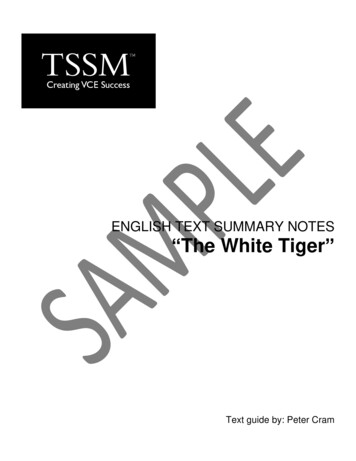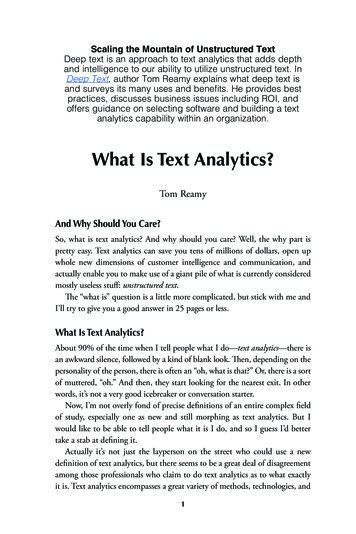
Transcription
ENGLISH TEXT SUMMARY NOTES“The White Tiger”Text guide by: Peter Cram
The White TigerCopyright TSSM 2015TSSMACN 099 422 670ABN 54 099 422 670A: Level 14, 474 Flinders Street Melbourne VIC 3000T: 1300 134 518F: 03 97084354W: tssm.com.auE: info@tssm.com.au2
The White Tiger3ContentsAUTHOR NOTES . 4HISTORICAL CONTEXT . 5GENRE . 6STRUCTURE . 7STYLE . 8SETTING. 11PLOT SUMMARY. 14CHARACTER PROFILES. 36Major Characters . 36Secondary and Tertiary Characters . 45THEMES AND ISSUES . 48IMPORTANT QUOTATIONS . 58SAMPLE ESSAY TOPICS . 74FINAL EXAMINATION ADVICE . 76REFERENCES . 76
The White Tiger4AUTHOR NOTESAravind Adiga was born in Madras, which is now called Chennai, in 1974. One grandfather was a chairman ofthe Karnataka Bank, and one was a doctor and Congress Party politician.Adiga grew up in Mangalore and was a student at St. Aloysius High School – a school run by the Jesuit order ofthe Roman Catholic Church.He attended Columbia and Oxford universities, where he studied Englishliterature.After university, Adiga worked as a journalist, publishing work as a correspondentwith Timemagazine, and with the Financial Times.His first novel, The White Tiger, was published in 2008 and was named a New York Times Bestseller. It wasalso awarded the Booker Prize, one of the world’s richest literary prizes, in 2008. Adiga has subsequentlypublished two other books: Between the Assassinations, a collection of 12 interlinked short stories, and thenovel Last Man in the Tower.
The White Tiger5HISTORICAL CONTEXTThe Republic of India, geographically forming the largest part of the ‘sub-continent’ in south Asia, isthe seventh-largest country in the world by area, and the second-most populous country with more than 1.2billion people. It is governed by a national parliament under the Constitution of India, and is a representativedemocracy. It is the most populous democracy in the world – a general election in India is the world’s largesthuman event. India is a federation, with a national government and 29 State governments and 7 Territories.India does not have a national language. While the Constitution recognises 21 ‘scheduled’ languages, Hindi hasthe largest number of speakers and is the official language of government. However, English is widely spokenin business and public administration, and is also important in education, especially at tertiary level. English isregarded as a ‘subsidiary official language’ by the Indian Ministry of Home Affairs.India has the world’s 9th largest economy, which is one of the world's fastest-growing. The country has beenopening its economy to the global free market since 1991.Major industries include textiles,telecommunications, chemicals, pharmaceuticals, biotechnology, food processing, steel, transport equipment,cement, mining, petroleum, machinery, and software.Its economy is recognized as innovative and ahead ofeven some advanced economies. It has7 of the world's top 15 information technology outsourcing companies.India's telecommunications industry is the world's fastest-growing, with the 3rd largest smartphone market inthe world after China and the USA – it added 227 million subscribers in 2010–11.India’s automotive industry isthe world's 2nd fastest growing. The pharmaceutical industry is one of the important emerging markets for theworld’s industry and is expected to reach nearly 50 billion by 2020.India facesnumerous socio-economic challenges. India has the largest concentration of people living below theinternational poverty line of US 1.25/dayas set by the World Bank, although the numbers have fallen from60% in 1981 to 25% in 2011. An estimated 44% of India's children under5 years of age are underweight andsuffer from chronic malnutrition; in many states up to 70% are anaemic. There is a Mid-Day Meal Scheme,which provides free lunches to primary school children to try to deal with malnutrition. Economic inequality isa significant problem, especially between the wealthier and poorer states. Corruption isbelieved to haveincreased significantly –a report estimatesthat illegal capital flows since independence in 1946 amountstoUS 462 billion.One report estimates that India's GDP could pass the USA’s by 2045. India’seconomy isgrowing at around 8%per year, and this makes it one of the world's fastest-growing major economies. Major economic growth areasare the young and increasing working-age population, manufacturing supported by rising education andengineering skills, and a growing consumer market supported by an increasing middle class.One ratings agencyreports that India’s economic problems include inflation pressures, weak public finances, and theineffectiveness of the government.Another ratings agency hasreported that decliningeconomic growth andpolitical problems in economic policy-making could cause problems.
The White Tiger 4 AUTHOR NOTES Aravind Adiga was born in Madras, which is now called Chennai, in 1974. One grandfather was a chairman of the Karnataka Bank, and one was a doctor and Congress Party politician. Adiga grew up in Mangalore and was a student at St. Aloysius High School - a school run by the Jesuit order of










![English Text Book[1] - Weebly](/img/4/comprehension-and-communication-skills-in-english-engl101.jpg)
